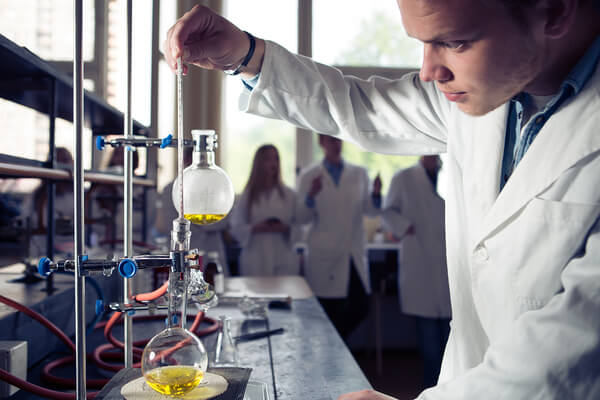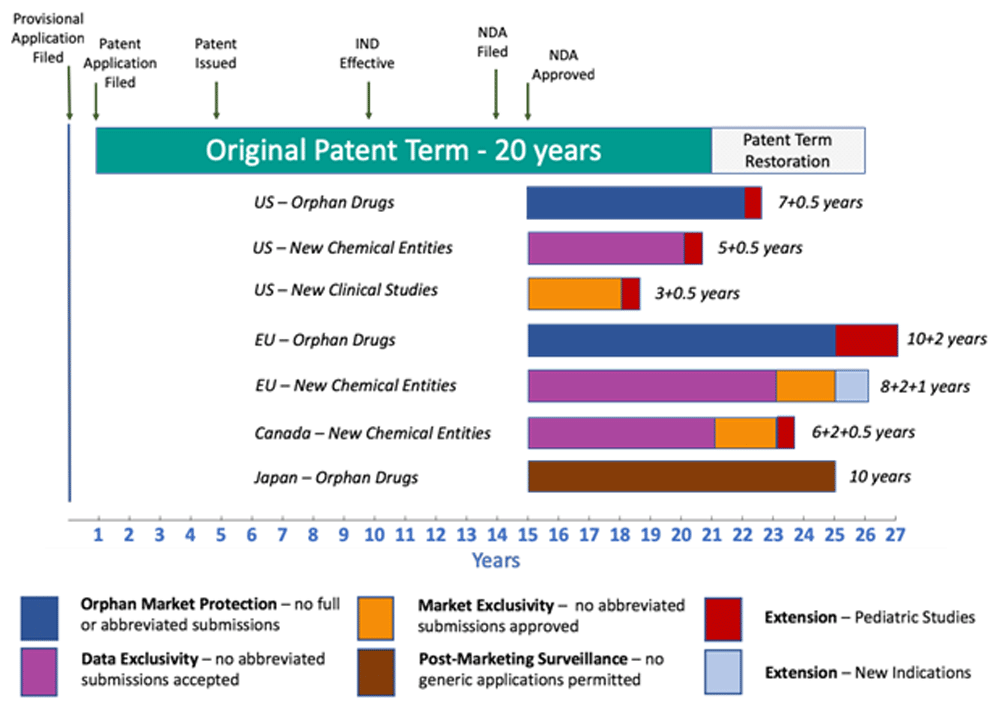Drug patents represent one of the most complex and consequential aspects of the pharmaceutical industry, balancing innovation incentives with public access to potentially life-saving medications. While the standard patent term is 20 years from filing, the real-world protection period for pharmaceuticals involves numerous nuances, extensions, and strategic considerations. This comprehensive guide explores the multifaceted nature of drug patent duration, examining how regulatory processes, extension mechanisms, and global variations shape market exclusivity periods that ultimately impact healthcare costs and accessibility worldwide.
The Fundamentals of Drug Patent Protection
What Exactly Is a Drug Patent?
A drug patent is a form of intellectual property protection granted to pharmaceutical companies, providing them exclusive rights to manufacture, market, and sell a specific medication for a defined period. These patents can cover various aspects of a drug, including the active ingredient, formulations, manufacturing methods, and specific therapeutic uses[2]. This temporary monopoly allows companies to recoup the substantial investments required for research and development.
Drug patents represent a critical component of the pharmaceutical business model. Without this protection, competitors could immediately copy and market successful drugs without bearing the enormous research costs, significantly undermining innovation incentives. The patent system essentially represents a societal bargain: temporary market exclusivity in exchange for developing new treatments and publicly disclosing inventions that eventually enter the public domain.
Why Patents Matter in Pharmaceutical Innovation
The pharmaceutical industry depends heavily on patent protection to sustain its innovation model. Developing a new drug typically requires investments upwards of $2 billion and takes many years of research, clinical trials, and regulatory processes[1]. This high-risk, high-cost process means that without guaranteed periods of market exclusivity, many potentially valuable treatments might never be developed.
Patents serve multiple purposes beyond simply protecting revenue streams. They encourage disclosure of scientific discoveries that might otherwise remain trade secrets, facilitate knowledge sharing across the research community, and provide clear legal frameworks for licensing and collaboration. The temporary monopoly granted by patents represents a careful balance between rewarding innovation and ensuring that medical advances eventually become widely accessible.
The Standard 20-Year Term and Its Limitations
The Basic Patent Timeline
Like most patents, drug patents have a standard term of 20 years from the filing date of the patent application[1][2]. This timeframe was established to provide inventors with sufficient time to commercialize their inventions while ensuring that innovations eventually enter the public domain. However, this 20-year period can be misleading when considering pharmaceuticals specifically.
A critical distinction for drug patents is that the patent clock starts ticking as soon as the application is filed, which typically occurs early in the drug development process—often during initial discovery or first clinical trials[1]. This means that a significant portion of the patent term may elapse before the drug ever reaches the market, effectively reducing the period of market exclusivity.
The Reality of Effective Patent Life
Due to the extensive development and approval processes unique to pharmaceuticals, the effective patent life—the time a patented drug actually enjoys market exclusivity—is significantly shorter than the nominal 20-year term. On average, drugs enjoy about 12-14 years of market exclusivity rather than the full 20 years[2]. This gap represents a critical business consideration for pharmaceutical companies.
The journey from patent filing to market entry involves multiple phases, each consuming precious years of patent protection:
- Preclinical research and laboratory testing
- Phase I clinical trials (safety testing in healthy volunteers)
- Phase II clinical trials (efficacy testing in a small patient population)
- Phase III clinical trials (large-scale testing for safety and efficacy)
- FDA review and approval process
- Manufacturing scale-up and commercialization preparations
By the time a drug finally receives approval and reaches the market, many years of its original 20-year patent term have often already expired[1]. This reality has led to the development of various mechanisms to partially restore this lost protection time.
Patent Term Extensions: Compensating for Regulatory Delays
The Hatch-Waxman Act and Its Provisions
Recognizing the unique challenges faced by pharmaceutical products due to lengthy regulatory reviews, Congress passed the Drug Price Competition and Patent Term Restoration Act of 1984, commonly known as the Hatch-Waxman Act[4][6]. This landmark legislation created a balanced approach, simultaneously streamlining generic drug approvals while providing mechanisms to partially restore patent terms lost during regulatory review.
The Hatch-Waxman Act established the Patent Term Extension (PTE) system, which allows pharmaceutical patent holders to reclaim some of the time spent in regulatory review. This provision acknowledges that unlike most other industries, drug manufacturers cannot commercialize their inventions immediately after development due to mandatory regulatory oversight.
Eligibility Criteria for Patent Term Extensions
Not all pharmaceutical patents qualify for term extensions. According to the provisions outlined in the Hatch-Waxman Act, a patent must meet several specific conditions to be eligible for a PTE:
- The patent must not have expired at the time of application
- The patent term must never have been previously extended
- The application must be submitted by the owner of record or its agent
- The product must have undergone a regulatory review period before commercial marketing
- The permission for commercial marketing must be the first permitted commercial use of the product (with certain exceptions for products made using recombinant DNA technology)[4][6]
Additionally, only one patent can be extended per approved product, even if multiple patents cover different aspects of the same drug. This forces companies to strategically select which patent to extend, typically choosing the one that provides the broadest protection or has the latest expiration date.
How Extensions Are Calculated
The calculation of patent term extensions involves a carefully designed formula that accounts for different phases of the regulatory process. The maximum extension period is calculated based on:
- The entire regulatory review period consists of:
- The “testing phase” (from IND effective date to NDA submission)
- The “approval phase” (from NDA submission to FDA approval)
However, several adjustments apply to this calculation:
- Only 50% of the testing phase is counted toward the extension
- 100% of the approval phase is counted
- Days that elapsed before the patent was issued are subtracted
- Periods during which the applicant did not act with “due diligence” are excluded[6]
“The maximum term extension is five (5) years, provided that the extension does not result in a total remaining patent term of more than fourteen (14) years. This 14-year period is measured from the date the drug product received regulatory approval up to the date of patent expiration (with term extension).”[4]
This calculation methodology aims to compensate specifically for time lost in regulatory review rather than providing blanket extensions unrelated to actual delays. The formula ensures that the extension is proportionate to the actual time spent navigating the regulatory process.
Maximum Extension Limitations
While the Hatch-Waxman Act provides valuable extensions, there are strict limits to prevent excessive monopoly periods:
- The maximum extension cannot exceed five years, regardless of how long the regulatory review took
- The total patent term after extension cannot exceed 14 years from the date of FDA approval[4][6]
These caps ensure that while innovators receive fair compensation for regulatory delays, there remains a reasonable timeline for generic entry. The 14-year cap is particularly significant, as it establishes a relatively predictable outer limit for market exclusivity, allowing generic manufacturers and healthcare systems to plan accordingly.
FDA Exclusivity: Additional Protection Beyond Patents
New Chemical Entity (NCE) Exclusivity
Beyond patent protection, the FDA offers several types of regulatory exclusivity that provide additional market protection for drugs meeting certain criteria. New Chemical Entity (NCE) exclusivity grants five years of protection for drugs containing active ingredients that have never been approved by the FDA[1]. During this period, generic manufacturers cannot submit abbreviated applications referencing the innovative drug’s safety and efficacy data.
This exclusivity runs concurrently with patent protection but may extend beyond patent expiration in certain cases. NCE exclusivity recognizes the significant investment required to develop entirely new molecular entities rather than modifications of existing compounds. This additional protection helps ensure that truly novel medications receive adequate market protection.
Orphan Drug Exclusivity
Orphan Drug Exclusivity provides seven years of market protection for drugs treating rare diseases affecting fewer than 200,000 Americans[1]. This extended exclusivity period serves as an additional incentive to develop treatments for conditions that might otherwise receive limited research attention due to small patient populations and challenging return on investment calculations.
The impact of this exclusivity has been substantial. Before the Orphan Drug Act’s passage in 1983, fewer than 10 drugs for rare diseases had been developed; since then, hundreds of orphan drugs have received approval. This exclusivity period plays a crucial role in the economic viability of these specialized treatments, allowing companies to recoup investments despite relatively small markets.
Pediatric Exclusivity
The pediatric exclusivity provision offers an additional six months of protection for conducting FDA-requested studies in children[1]. This provision addresses the historical underrepresentation of pediatric populations in clinical trials by creating financial incentives for companies to generate pediatric-specific safety and dosing data.
The six-month extension applies to all existing patent and non-patent exclusivity for the drug, effectively extending the entire exclusivity portfolio. For blockbuster medications, this relatively short extension can represent hundreds of millions in additional revenue, making pediatric studies economically attractive despite their additional complexity and ethical considerations.
Clinical Investigation Exclusivity
For modifications to previously approved drugs, the FDA offers three years of exclusivity for conducting new clinical investigations essential to the approval[1]. This applies to new indications, formulations, dosing regimens, or patient populations for existing medications. While shorter than NCE exclusivity, this protection encourages companies to continue researching approved drugs and expanding their therapeutic applications.
This three-year exclusivity prevents generic manufacturers from gaining approval for the specific aspects covered by the new clinical investigations, though they may still pursue approval for previously approved uses or formulations. This tiered approach balances continued innovation incentives with appropriate limits on exclusivity for incremental improvements.
Strategic Patent Management in Pharmaceuticals
Patent Layering and Portfolio Development
Pharmaceutical companies typically employ sophisticated strategies to maximize market exclusivity beyond the basic compound patent. A single drug product often has multiple patents covering different aspects:
- Active ingredient patents (the core chemical compound)
- Formulation patents (specific drug compositions)
- Method-of-use patents (treating specific conditions)
- Manufacturing process patents (unique production methods)
- Polymorph patents (different crystalline forms of the same compound)
By securing this diverse portfolio of patents with staggered expiration dates, companies can create layered protection extending well beyond the original compound patent[1]. Each patent in the portfolio may have different filing dates, resulting in different expiration timelines. This approach creates a more complex landscape for generic competitors to navigate, potentially extending effective market exclusivity.
Secondary Patents and Their Impact
Secondary patents—those covering aspects beyond the core chemical compound—play an increasingly important role in pharmaceutical exclusivity strategies. For example, particular formulations (extended-release versions, injectable forms, etc.) or specific therapeutic uses may receive separate patent protection with later expiration dates than the original compound patent.
According to industry data, the average successful drug now has multiple patents, with many blockbuster medications protected by dozens of patents covering various aspects. While these secondary patents may not block all generic competition (particularly for different formulations or indications), they can significantly complicate market entry and preserve substantial revenue streams even after the original compound patent expires.
Case Studies of Patent Lifecycle Management
Examining specific medications illustrates the sophisticated patent strategies employed in the pharmaceutical industry. For instance, let’s consider Entresto, a heart failure medication from Novartis with $1.7 billion in 2018 sales. This drug is protected by multiple patents with staggered expiration dates:
- US8404744 (expired July 14, 2023)
- US8796331 (expired July 14, 2023)
- US7468390 (expired November 27, 2023)
- US8101659 (expiring January 15, 2025)[3]
This layered protection means that even though some patents have already expired, the drug continues to enjoy market exclusivity through remaining patents. Similarly, Spinraza, a treatment for spinal muscular atrophy, has patents extending from 2023 to 2030, creating a prolonged exclusivity period for this breakthrough therapy[3].
The Impact of Patent Expiration
Generic Entry and Market Dynamics
When drug patents expire, generic manufacturers can enter the market with bioequivalent versions of the original medication. Generic entry typically occurs rapidly for commercially successful drugs, with multiple companies often launching competing versions within months of patent expiration. This competition fundamentally transforms the market dynamics for the affected medication.
The generic approval process is streamlined through the Abbreviated New Drug Application (ANDA) pathway, which allows manufacturers to rely on the original drug’s safety and efficacy data rather than conducting full clinical trials. Generic applicants need only demonstrate bioequivalence – proving that their version delivers the same amount of active ingredient to the bloodstream at the same rate as the original. This simplified pathway, established by the Hatch-Waxman Act, enables much faster and less expensive market entry[1].
Price Impact and Consumer Benefits
Patent expiration and subsequent generic entry typically result in dramatic price reductions. Research consistently shows that generic competition drives branded drug prices down by 80-90% from their pre-expiration levels[1]. This price collapse occurs progressively as more generic competitors enter the market, with the most significant drops occurring when multiple generics are available.
The first generic entrant typically prices its product 20-30% below the brand-name version, gaining significant market share while still maintaining relatively high margins. As additional generics enter, prices continue to fall through increased competition. Eventually, prices often approach the marginal cost of production, particularly for small-molecule drugs with straightforward manufacturing processes.
Brand Response Strategies
Branded pharmaceutical companies employ various strategies to mitigate the impact of patent expiration:
- Authorized generics: Launching their own generic version or partnering with a generic manufacturer to capture a portion of the generic market
- Product hopping: Developing and transitioning patients to next-generation products with remaining patent protection
- Over-the-counter conversion: Switching prescription medications to over-the-counter status where appropriate
- Brand loyalty programs: Implementing discount programs and patient assistance initiatives to maintain brand loyalty
Despite these efforts, most branded drugs experience substantial revenue declines following patent expiration, highlighting the critical importance of patent protection to the pharmaceutical business model. Industry data shows that branded products typically lose 80-90% of their market share within a year of generic entry[1].
Global Perspectives on Drug Patent Duration
International Differences in Patent Terms
While the standard 20-year patent term has been harmonized across most countries through international agreements like TRIPS (Trade-Related Aspects of Intellectual Property Rights), significant differences remain in how these terms are implemented and extended. Different countries have varying approaches to:
- Extension mechanisms for regulatory delays (similar to US Patent Term Extension)
- Supplementary Protection Certificates in the European Union
- Data exclusivity periods that operate independently from patents
- Different approaches to patent term calculation and adjustment
These variations mean that a drug may lose patent protection at different times in different markets. For instance, a medication might face generic competition in certain countries years before patents expire in others, creating complex global marketing and pricing strategies.
Strategic Geographic Filing Considerations
Pharmaceutical companies typically pursue patent protection in multiple countries simultaneously to secure global market exclusivity. However, patent laws vary significantly across jurisdictions, requiring sophisticated international filing strategies. Most companies focus their patenting efforts on major pharmaceutical markets – North America, Europe, Japan, and increasingly, China and India – while making strategic decisions about smaller markets based on commercial potential and enforcement realities.
According to recent data, China leads global pharmaceutical patent filings, accounting for 33% of filings in Q3 2024, followed by the United States with 14% and Japan with 6%[5]. This geographic distribution reflects both the globalization of pharmaceutical research and the strategic importance different countries place on building their life sciences sectors.
Balancing Global Innovation and Access
The pharmaceutical patent system faces ongoing tensions between providing sufficient incentives for innovation and ensuring widespread access to medications. These tensions are particularly acute in the global context, where economic disparities create significant challenges for balancing innovation rewards with medication affordability.
Various approaches have emerged to address these tensions, including:
- Voluntary licensing agreements between patent holders and generic manufacturers for developing markets
- Tiered pricing strategies based on countries’ economic development levels
- Public-private partnerships for diseases primarily affecting lower-income populations
- Government use of flexible policy tools like compulsory licensing in specific circumstances
These approaches recognize that the optimal balance between innovation incentives and access considerations may vary across different therapeutic areas, patient populations, and economic contexts.
Current Trends in Pharmaceutical Patenting
Patent Filing Statistics and Activities
The pharmaceutical industry continues to be among the most active sectors for patent filings globally, though recent data shows some fluctuation in activity. According to GlobalData’s Patent Analytics, the global pharmaceutical industry experienced a 14% decline in patent filings in Q3 2024 compared to the previous quarter, with total filings numbering 62,965[5]. This represents an 11% year-on-year decrease in filings.
Similarly, patent grants in the pharmaceutical sector decreased by 11% year-on-year and 14% quarter-on-quarter[5]. These trends may reflect various factors, including industry consolidation, changing R&D priorities, economic pressures, or shifting innovation strategies. Despite these recent fluctuations, pharmaceutical patenting remains robust compared to historical levels, indicating continued investment in drug development and innovation.
Leading Companies and Their Patent Portfolios
The pharmaceutical patent landscape features both established industry giants and emerging research institutions. According to recent data, the top five companies accounted for approximately 3% of patenting activity in the pharmaceutical sector[5]. Among the leaders, Roche led with 538 patent filings in Q3 2024, followed by Zhejiang University with 359 filings and Regeneron Pharmaceuticals with 354 filings[5].
The presence of academic institutions like Zhejiang University among the top patent filers highlights the increasing importance of university research in pharmaceutical innovation. This trend reflects the evolving innovation ecosystem, where groundbreaking discoveries often emerge from academic laboratories before being developed commercially through licensing agreements or spin-off companies.
Focus Areas for Future Patent Protection
Patent filing trends indicate several emerging focus areas for pharmaceutical innovation and patent protection:
- Biologics and biosimilars: As complex biological therapies become increasingly important, patent strategies are evolving to address their unique characteristics
- Digital therapeutics and combination products: The integration of software, devices, and pharmaceuticals creates new patenting challenges and opportunities
- Precision medicine approaches: Targeted therapies based on genetic profiles require sophisticated patent strategies covering diagnostic methods, treatments, and companion technologies
- Alternative delivery systems: Novel routes of administration that improve efficacy or patient compliance represent valuable patent opportunities
- AI-driven drug discovery: Applications of artificial intelligence in identifying and optimizing drug candidates are generating new types of intellectual property claims
These trends suggest continued evolution in pharmaceutical patenting strategies, with implications for how market exclusivity will function in the coming decades.
Challenges and Controversies in Drug Patent Duration
Balancing Innovation Incentives and Access
The pharmaceutical patent system faces ongoing tensions between providing sufficient incentives for innovation and ensuring widespread access to medications. Longer and stronger patent protections may stimulate greater R&D investment but can also delay generic competition and keep prices higher for extended periods. Conversely, weaker patent protections might improve short-term affordability but potentially reduce investment in future treatments.
This tension is particularly evident in debates about patent term extensions and evergreening strategies. While innovator companies argue that adequate protection periods are essential for sustaining the high-risk, high-cost drug development process, patient advocates and public health organizations often push for limits on patent extensions to facilitate earlier generic entry and improve medication affordability.
Evergreening and Patent Thickets
“Evergreening” refers to the strategic practice of obtaining additional patents on modified versions, new delivery methods, or new uses of existing drugs to extend market exclusivity. While these innovations may provide genuine patient benefits, critics argue that some represent minimal clinical improvements designed primarily to extend exclusivity periods.
Similarly, “patent thickets” – dense webs of overlapping intellectual property rights – can create complicated barriers to generic entry even after key patents expire. These complex patent landscapes require generic manufacturers to navigate numerous potential infringement risks, potentially delaying competition beyond what policymakers intended when designing the patent system.
Reform Proposals and Policy Directions
Various stakeholders have proposed reforms to address perceived imbalances in the pharmaceutical patent system:
- More stringent patentability standards: Requiring more substantial innovation for secondary patents
- Limits on patent term extensions: Capping or further restricting extensions for certain types of innovations
- Alternative incentive models: Exploring prizes, advance market commitments, or research subsidies as complements to patent protection
- Transparency requirements: Mandating disclosure of R&D costs to better align exclusivity periods with actual innovation investments
- Expedited challenge processes: Streamlining procedures for challenging potentially invalid pharmaceutical patents
These reform discussions reflect the ongoing challenge of calibrating the patent system to achieve its dual goals of rewarding innovation while ensuring eventual competition and affordability. The optimal balance likely varies across different therapeutic areas and types of innovations, suggesting that a one-size-fits-all approach may not be ideal.
The Future of Drug Patent Protection
Emerging Technologies and Patent Implications
The pharmaceutical landscape is evolving rapidly with new technologies that present unique patent challenges:
- Cell and gene therapies: These potentially curative treatments raise questions about appropriate exclusivity periods for one-time interventions
- CRISPR and gene editing: The revolutionary nature of these technologies has generated complex patent disputes and licensing landscapes
- Artificial intelligence in drug discovery: AI-generated innovations create novel questions about inventorship and patentability
- Digital therapeutics: Software-based interventions blur traditional boundaries between medical devices and pharmaceuticals
- Nanotechnology delivery systems: Microscale innovations in drug delivery present new patentable opportunities beyond traditional chemical compounds
These emerging technologies may require adaptations to existing patent frameworks to appropriately balance innovation incentives with access considerations. The complex nature of these innovations often involves multiple patent holders and requires sophisticated licensing arrangements to bring products to market.
Potential Policy Evolution
Looking forward, several policy trends may influence pharmaceutical patent terms and exclusivity:
- Increasing focus on value-based approaches that link exclusivity periods to demonstrated clinical benefits
- Growing pressure for greater transparency in the relationship between R&D investments and exclusivity periods
- Potential reforms to address concerns about patent thickets and evergreening strategies
- Evolution of regulatory exclusivity provisions to complement patent protection for specific innovation types
- Greater international harmonization of patent terms and extension mechanisms to reduce global disparities
These developments suggest that while the fundamental 20-year patent term may remain stable, the practical implementation of pharmaceutical exclusivity will likely continue to evolve through both policy reforms and industry adaptation.
Striking a Balance for the Future
The ongoing challenge for policymakers, industry leaders, patient advocates, and healthcare systems is finding the optimal balance that promotes continued pharmaceutical innovation while ensuring affordable access to medications. This balance requires nuanced approaches that:
- Provide sufficient rewards for truly transformative innovations that address unmet medical needs
- Limit excessive exclusivity for minor modifications with minimal clinical benefits
- Consider affordability and access implications alongside innovation incentives
- Adapt to the changing nature of pharmaceutical R&D and emerging technologies
- Account for global disparities in healthcare resources and needs
Ultimately, the drug patent system serves as a means to an end—promoting the development of life-improving and life-saving medications—rather than an end in itself. Future evolution of patent terms and exclusivity provisions should remain focused on this fundamental purpose.
Key Takeaways
- The standard patent term for drugs is 20 years from filing, but effective market exclusivity is typically 7-12 years due to development and approval timelines[1][2].
- Patent Term Extensions can add up to 5 years to compensate for regulatory review time, but total market exclusivity cannot exceed 14 years from FDA approval[4][6].
- Additional exclusivity mechanisms include FDA-granted periods for new chemical entities (5 years), orphan drugs (7 years), pediatric studies (6 months), and new clinical investigations (3 years)[1].
- Companies employ strategic patent layering with multiple patents covering different aspects of drugs to extend effective market protection[1][3].
- Patent expiration typically leads to generic entry, causing 80-90% price reductions and significant market share losses for branded products[1].
- Global patent protection varies by country, creating complex international exclusivity landscapes with different expiration dates across markets[5].
- Current trends show fluctuations in pharmaceutical patent filings, with China leading global activity at 33% of filings, followed by the US (14%) and Japan (6%)[5].
The pharmaceutical patent system continues to evolve through policy reforms, court decisions, and industry strategies, all seeking to balance innovation incentives with medication access and affordability.
FAQs About Drug Patent Duration
What is the difference between a drug’s patent term and its effective market exclusivity?
While a drug’s patent term is technically 20 years from filing, the effective market exclusivity period is substantially shorter. This discrepancy occurs because patents are typically filed early in the drug development process, but several years are consumed by clinical trials and regulatory review before the drug reaches the market[1][2]. On average, drugs enjoy about 12-14 years of market exclusivity rather than the full 20 years[2]. Patent Term Extensions can partially compensate for this lost time, adding up to 5 years to the patent term, but they cannot extend total market exclusivity beyond 14 years from FDA approval[4][6].
Can pharmaceutical companies obtain multiple patents for the same drug?
Yes, pharmaceutical companies routinely secure multiple patents covering different aspects of the same drug. These can include patents on the active ingredient, specific formulations, manufacturing processes, and methods of treatment[1][3]. For example, Entresto, a heart failure medication, has multiple patents with expiration dates ranging from 2023 to 2025[3]. This layered patent strategy helps companies extend effective market protection beyond what would be possible with a single patent. Each patent must meet standard patentability requirements of novelty, non-obviousness, and utility, but may cover incremental innovations beyond the core compound.
How do orphan drug designations affect patent terms and exclusivity?
Orphan drug designation doesn’t directly extend the patent term, but it provides an additional 7 years of market exclusivity from the date of FDA approval for drugs treating rare diseases (affecting fewer than 200,000 Americans)[1]. This exclusivity runs concurrently with patent protection but may extend beyond patent expiration in cases where limited patent life remains at approval. The orphan exclusivity prevents approval of the same drug for the same indication, even if all patents have expired, unless the second product demonstrates clinical superiority. This additional protection has successfully stimulated development of hundreds of treatments for rare diseases since the Orphan Drug Act’s passage in 1983.
What happens to drug prices when patents expire?
When drug patents expire and generic competition enters the market, prices typically decline dramatically. Research shows that generic competition drives branded drug prices down by 80-90% from their pre-expiration levels[1]. This price reduction occurs progressively as more generic manufacturers enter the market. The first generic entrant usually prices 20-30% below the brand name product, but as additional competitors join, prices continue to fall toward the marginal cost of production. Simultaneously, branded products typically lose 80-90% of their market share within a year of generic entry[1], as insurance plans implement policies encouraging generic substitution through lower copayments and automatic pharmacy substitution.
How do international differences in patent laws affect global drug availability?
International differences in patent laws create significant variations in when drugs become available as generics in different countries. While most countries recognize a 20-year base patent term through TRIPS agreements, differences in extension mechanisms, patentability standards, and regulatory exclusivity create a complex global landscape. Some countries have more stringent patentability requirements or more limited extension options, potentially allowing earlier generic entry. These variations mean patients in different countries may have access to affordable generic versions of the same drug at substantially different times. Recent data shows China leads pharmaceutical patent filings with 33% of global activity, followed by the US (14%) and Japan (6%)[5], reflecting diverse national innovation strategies.
Citations:
[1] https://www.upcounsel.com/how-long-does-a-drug-patent-last
[2] https://www.drugpatentwatch.com/blog/when-do-drug-patents-expire/
[3] https://www.greyb.com/blog/drug-patents-expiring-2023/
[4] https://www.alacrita.com/whitepapers/pharmaceutical-patent-term-extension-an-overview
[5] https://www.pharmaceutical-technology.com/data-insights/patent-activity-pharmaceutical-industry/
[6] https://www.drugpatentwatch.com/blog/patent-term-extension-calculator-step-by-step-expert-guide/
[7] https://www.drugpatentwatch.com/blog/how-long-do-drug-patents-last/
[8] https://www.abpi.org.uk/value-and-access/uk-medicine-pricing/medicine-lifecycle/
[9] https://touromed.libguides.com/c.php?g=1263476
[10] https://www.ajmc.com/view/a636-article
[11] https://www.merck.com/wp-content/uploads/sites/124/2023/12/Patent-Term-Extensions_MRK_DEC11.pdf
[12] https://anderson-review.ucla.edu/52-6-billion-extra-cost-to-consumers-of-add-on-drug-patents/
[13] https://www.drugpatentwatch.com/blog/how-long-does-a-patent-last-for-drugs/
[14] https://www.drugpatentwatch.com/blog/patent-term-extension-for-drugs-not-limited-to-new-chemical-entities/
[15] https://jamanetwork.com/journals/jamainternalmedicine/fullarticle/2818277
[16] https://www.fda.gov/drugs/development-approval-process-drugs/frequently-asked-questions-patents-and-exclusivity
[17] https://pubmed.ncbi.nlm.nih.gov/28719222/
[18] https://www.statista.com/statistics/309404/global-total-prescription-drug-revenue-at-risk-from-patent-expiration/
[19] https://www.fda.gov/media/92548/download
[20] https://www.ahip.org/news/press-releases/getting-the-facts-big-pharma-increasingly-using-patent-games-to-avoid-competition
[21] https://www.cornelllawreview.org/2023/07/25/pharmaceutical-patent-protection-beyond-the-twenty-year-statutory-term/
[22] https://www.ey.com/en_us/insights/life-sciences/navigating-pharma-loss-of-exclusivity
[23] https://www.biopharmadive.com/news/patent-cliff-pharmaceuticals-top-drugs-monopoly-expiration/715062/
[24] https://torreypineslaw.com/pharmaceutical-lifecycle-management.html
[25] https://www.sternekessler.com/news-insights/publications/patent-term-extension/
[26] https://patentpc.com/blog/patent-term-extension-statistics-what-innovators-need-to-know/
[27] https://www.drugpatentwatch.com/blog/the-power-of-patience-delaying-patents-to-enhance-pharma-market-exclusivity/
[28] https://undark.org/2021/06/16/how-patent-extensions-keep-some-drug-costs-high/
[29] https://yalelawandpolicy.org/patent-term-extensions-and-last-man-standing
[30] https://www.contractpharma.com/exclusives/drug-patents-exclusivity-lessons-from-humira-a-biosimilars-boom/
[31] https://www.drugpatentwatch.com/blog/leveraging-a-drug-patent-portfolio-for-success/
[32] https://www.fr.com/insights/ip-law-essentials/intro-patent-term-extension/
[33] https://c4ip.org/new-expert-analysis-from-c4ip-co-chair-david-kappos-congress-must-consider-accurate-data-about-patent-thickets/
[34] https://www.congress.gov/crs-product/R46679
[35] https://www.princeton.edu/~ota/disk3/1981/8119/811906.PDF











![Is Patent “Evergreening” Restricting Access to Medicine/Device Combination Products? Fig 2. Sales for 8 medication-device combination products in 100-top sellers in the US from 2011–2013 [22]](https://www.drugpatentwatch.com/blog/wp-content/uploads/2019/03/Fig-2.-Sales-for-8-medication-device-combination-products-in-100-top-sellers-in-the-US-from-2011–2013-22.png)











